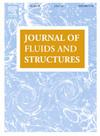Role of turbulence on high-speed aeroelastic behavior of a cantilever plate
IF 3.4
2区 工程技术
Q1 ENGINEERING, MECHANICAL
引用次数: 0
Abstract
Accurate and efficient prediction of high-speed aeroelastic behavior is greatly hampered by insufficient understanding of the role of multi-scale fluid features on structural dynamics. In this work, we use a combination of scale-resolving and modeled simulations to evaluate the significance of capturing coupling with the broadband turbulent pressure fluctuations on prediction of the aeroelastic response. A Mach 2 turbulent flow separating from a cantilever plate is considered at nondimensional dynamic pressures of and 150. The fully coupled Large-Eddy Simulations (LES) predict sustained oscillations, with larger amplitudes and modal coalescence for the higher and shock-induced separation on the cantilever top surface. The significance of capturing dynamic feedback between the broadband turbulence and structural compliance is highlighted through aeroelastic response prediction comparisons between LES and URANS. Here, wall pressure fluctuations are extracted from LES data about undeformed and time-mean deflected states of the cantilever and separately added to coupled URANS simulations. The results indicate that key aspects of the aeroelastic behavior can be recovered by URANS in conjunction with an uncoupled turbulent load. However, clear differences in response frequency and instantaneous amplitude remain present compared to LES, suggesting missing coupled phenomena from the URANS prediction.
湍流对悬臂板高速气动弹性特性的影响
由于对多尺度流体特征在结构动力学中的作用认识不足,高速气动弹性特性的准确和有效预测受到了很大的阻碍。在这项工作中,我们结合了尺度解析和模型模拟来评估捕获耦合与宽带湍流压力波动对预测气动弹性响应的重要性。考虑了在λ=100和150的无因次动压力下从悬臂板分离出来的2马赫湍流。完全耦合的大涡模拟(LES)预测了持续振荡,具有较大的振幅和模态聚并,在高λ和激波诱导的悬臂顶表面分离。通过LES和URANS的气动弹性响应预测比较,强调了捕获宽带湍流和结构柔度之间动态反馈的重要性。在这里,从悬臂梁未变形和时间平均偏转状态的LES数据中提取壁面压力波动,并分别添加到耦合URANS模拟中。结果表明,结合非耦合湍流载荷,URANS可以恢复气动弹性行为的关键方面。然而,与LES相比,响应频率和瞬时振幅仍然存在明显差异,这表明URANS预测中缺少耦合现象。
本文章由计算机程序翻译,如有差异,请以英文原文为准。
求助全文
约1分钟内获得全文
求助全文
来源期刊

Journal of Fluids and Structures
工程技术-工程:机械
CiteScore
6.90
自引率
8.30%
发文量
173
审稿时长
65 days
期刊介绍:
The Journal of Fluids and Structures serves as a focal point and a forum for the exchange of ideas, for the many kinds of specialists and practitioners concerned with fluid–structure interactions and the dynamics of systems related thereto, in any field. One of its aims is to foster the cross–fertilization of ideas, methods and techniques in the various disciplines involved.
The journal publishes papers that present original and significant contributions on all aspects of the mechanical interactions between fluids and solids, regardless of scale.
 求助内容:
求助内容: 应助结果提醒方式:
应助结果提醒方式:


